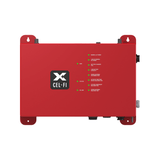Bring Your Small to Midsize Building Up to Code
The Nextivity (formerly Cel-Fi) SHIELD SOLO is for small to medium buildings having difficulty meeting their local public safety codes. It is an affordable solution for building owners to provide complete coverage of the 700/800 MHz public safety bandwidths. It acts as an ERRCS (Emergency Responder Radio Coverage System) and a BDA (bi-directional amplifier).


No Noise Guarantee
By actively monitoring RF environmental changes and performing adjustments in real time, SHIELD SOLO ensures emergency personnel stay connected in any situation by delivering industry-leading performance with a no noise guarantee.
Automatic Setting of Uplink Transmitted Power
SHIELD SOLO simplifies the optimization of uplink (UL) gain for emergency communication systems by eliminating the need for additional equipment or guessing the calculations. The system calculates path loss automatically, allowing for different values according to network requirements and the option to setup a target range.


Automatic Calculation and Setting of Isolation and Downlink Gain
While isolation is calculated in real-time and automatically set at 20 dB per NFPA 1221, the system allows for different values according to local ordinances. DL gain is automatically adjusted to achieve the required value.
Guaranteed Talk-Out to Eliminate Hassles
Nextivity's technology allows integrators to calculate the performance and reliability of the RF signal traveling from the donor antenna to the remote tower using a FRS radio (walkie-talkie) and Cel-FI WAVE PRO.


Built-In Grid Test Functionality
With Cel-Fi WAVE PRO and Cel-Fi COMPASS, system integrators can test the downlink (DL) signal for the design planning stage and post-install performance evaluation. Generate the Full Signal Report which includes key LMR/MNO parameters: Operator, RSSI, DAQ, Frequency, Band, PCI and more. Installers use system operation data to prepare for AHJ walk-through tests.
Remote Monitoring and Management
The web-based Cel-Fi WAVE Portal provides installers and authorized users remote monitoring, managing, and control of Cel-Fi ERRCS systems from anywhere. In addition to easily adapting Cel-Fi systems to local fire codes, the WAVE Portal allows users to customize notification and policy parameters. The intuitive platform also offers advanced performance metrics on Nextivity's individual components, including real-time high site-to-server antenna monitoring and donor signal quality reports.

Ensuring reliable communication for emergency personnel, the SHIELD SOLO public safety solution is a half-watt emergency radio communication system that delivers best-in-class talk-in and talk-out performance. An ERRCS that fully complies with current fire codes, SHIELD SOLO is an Integrated Public Safety BDA that provides 700/800 MHz Land Mobile Radio (LMR) coverage.
This versatile system can be configured as a Class A or Class B device in the field and accepts DC power from either the purpose-built Nextivity SHIELD SOLO Battery Backup Unit (BBU) or a certified third-party BBU device. SHIELD SOLO is NEMA 4 rated, listed to UL 2524, and compatible with other public safety systems.
The SHIELD SOLO Public Safety ERRCS is designed for small to midsize buildings. It is compatible with many accessories, including the SHIELD Remote Annunciator (RA), and the SHIELD Emergency Shutoff Switch. These provide even more customizability.
This is a small-medium enterprise level product. If you need public safety coverage for a large enterprise building, see the Nextivity SHIELD EXTEND.

- SHIELD SOLO Part # L41-7EB
- Wideband Directional Antenna Part # A32-V32-201
- LPDA-R Antenna Part # A62-V44-201
- (Optional) Battery Backup Unit (BBU) Part # L44-00
- (Optional) Remote Annunciator (RA) Part # F42-10R-100
- (Optional) Emergency Power-Off Switch (EPO) Part # F42-10E-100
- (Optional) Active Server Antenna Part # A33-10A-100
| BANDS | |
|---|---|
| Downlink (MHz) | LMR 700: 768–775 LMR 800: 851–861 |
| Uplink (MHz) | LMR 700: 798–805 LMR 800: 806–816 |
| Radio Performance | |
| Technology | P25/Analog |
| Downlink Output Power | 27 dBm |
| Uplink Output Power | 26 dBm |
| Minimum Input level (DL/UL) | -100 dBm / -90 dBm |
| Maximum Input level (DL/UL) | -20 dBm / -27 dBm |
| System Maximum Gain | 90 dB |
| Noise Figure at Max Gain | 5 dB |
| Return Loss | -8 dB |
| System Group Delay @ 12.5 kHz (usec) (Class A) | 28 |
| System Group Delay @ 100 kHz / 150 kHz (usec) (Class B) | 15 / 13.6 |
| Power | |
| Consumption @ 12 VDC | 62 W max |
| Environmental | |
| Operating temperature | -20 to 50°C / -4 to 122°F |
| Max surface temperature | 44°C (measured at 30°C ambient) / 111°F (measured @ 86°F ambient) |
| Relative humidity | 0% to 95% (non-condensing) |
| Product Ingress Protection (IP) Rating | NEMA 4 |
| External Ports | |
| Type-N female connectors (Donor & Server Antennas) | 2x |
| 24 pin alarm connector | 1x |
| RJ45 connector for connection to the remote annunciator | 1x |
| Terminal block for power-off switch and external alarms | 1x |
| DC port for connection to the battery backup unit | 1x |













